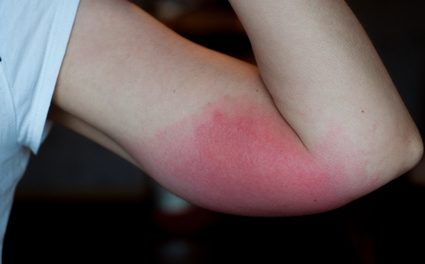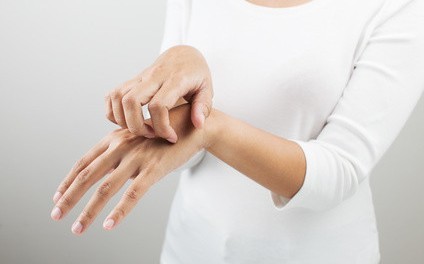Swollen Arm – Causes of Swelling of Hand, Forearm, Fingers
Swelling of the arm is an indication of inflammation or disturbances of blood or lymph flow causing a swollen appearance of the upper arm, forearm, hand or fingers. It rarely occurs on both sides at the same time. A sweollen arm is not always a cause for concern. Most cases are acute and quickly resolve on its own with no further problems. However, at other times the arm swelling can be a sign of serious conditions which needs prompt medical attention.
Why does the arm swell?
Swelling anywhere in the body is due to fluid accumulation. This fluid may be tissue fluid or blood. Normally there is a constant inflow and outflow of these fluids. However, when there is inflammation then more fluid flows in to the arm and this fluid accumulates in the tissue spaces. This causes swelling of the arm. Inflammation is the mechanism by which the body protects against tissue damage. It does not only occur in the arm.
Another reason for swelling is where blood accumulates in the tissue spaces. This may be seen as a red to purple bruising if it occurs under the skin. It signals a break in a blood vessel that allows the blood to flow out of the artery or vein. Similarly blood is constantly drained out of the arm through the veins. However, if the vein is blocked then the blood can accumulate in the arm and cause it to become swollen.
Lastly is the lymphathic fluid that can also accumulate and cause arm swelling. Lymphatic fluid is the excess tissue fluid that does not drain away into the veins. It is then drawn out of the tissue spaces and into the lymphatic vessels. Lymph nodes along the course of these lymphatic fluids then helps to filter the fluid. Finally the lymphatic fluid from the arm is emptied into a vein. However, if the lymphatic vessel or lymph node is blocked then swelling can occur.

Causes of a Swollen Arm
A swollen arm may be caused by a number of factors or predisposing conditions.
- Inflammation due to trauma (blunt force), injury (broken bones), overuse and exertion, toxins (poisonous substances, insect or snake bites), burns, allergies or chronic conditions like rheumatoid arthritis, carpal tunnel syndrome and gout .
- Lymphedema which is accumulation of lymphatic fluid in the arm. This is often associated with a swollen lymph node (lymphadenopathy).
- Infection – virus, bacteria, protozoa or fungi. Localized infection of the fingers, hand or forearm or a widespread infection of the arm as in cellulitis.
- Venous insufficiency are circulatory disorders due to chronic conditions (cardiac, peripheral vascular disease), injury to the vein or obstructed blood flow through the arm veins.
- Blood clots can occur inside arteries or veins anywhere in the body, including the arm. A clot can occur after blood samples are taken from the arm or an intravenous (IV) drip was in place.
- Fat accumulation due to hypothyroidism, Cushing’s syndrome or just general weight gain may cause swollen arms although this fat deposition is gradual and evident throughout the body.

Symptoms with Swollen Arm
The swelling of the arm may be accompanied by other signs and symptoms which may assist with diagnosing the cause of the swollen arm. It is difficult to identify a causative factor for a swollen arm solely on the swelling itself. The swollen arm should be assessed in conjunction with swelling throughout the body (generalized) or in specific areas (localized).
Swelling of the arm due to edema (in most cases) may be pitting (finger pressure leaves an impression on the swelling for a few seconds to minutes) or non-pitting edema. Pitting edema is usually indicative of a circulatory disorder while non-pitting edema may be an indication of a more localized cause like an injury, insect bite or an infection of the arm. It may only involve one arm (nilateral swelling) or both arms (bilateral swelling).
- Arm pain.
- Numbness or tingling of the arm.
- Itchy arm may also be experienced with or without an evident rash.
- Redness or paleness of the arm.
- Excessive warmth (heat) or cold and clammy skin.
- Muscle weakness which is reduced muscle strength or difficulty in moving the arm or complete loss of movement of the hand, forearm or fingers.
Treatment of Arm Swelling
It is important to take note of causative or aggravating factors in repeated episodes of arm swelling. A swollen arm may or may not be accompanied by other signs and symptoms and these concomitant symptoms should be reported to the attending practitioner when seeking medical attention.
Most importantly, it is advisable to take note if your swelling is one sided (unilateral) or of both arms (bilateral) as this may indicate a localized or generalized nature of the condition. If you are unsure of the cause of acute swelling, always immobilize your arm and seek medical attention immediately.
- Treatment depends on the cause of the inflammation, lymphedema, infection or venous insufficiency that is causing the swelling of the arm. Fat accumulation is usually gradual and gives the appearance of a swollen arm but is not a true swelling of the limb.
- Swelling of the fingers may likely be due to conditions like arthritis (more commonly rheumatoid arthritis) or gout (less common) and treatment should be directed at the cause of the joint swelling.
- It is not advisable to use a cold application such as an ice pack or immersing the hand in ice water if a swelling is noticed without identifying the cause. Cold therapy may only be useful in cases of blunt trauma immediately after the injury.
- Anti-inflammatory drugs may be useful in reducing swelling due to inflammation as well as easing any associated pain.
- Anti-histamines and corticosteroids may assist with swelling due to allergies or insect bites. In the event of a snake bite, seek immediate medical attention as the arm swelling may be accompanied by necrosis (tissue death). More importantly, snake venom will eventually enter the systemic circulation and can cause death.
- Certain circulatory disorders may have serious underlying pathologies including cardiovascular disease like congestive cardiac failure, kidney failure, liver failure, aneurysms and thrombosis. These conditions need to be identified and treated accordingly.
- Fractures (broken bones) within the arm, hand or fingers will cause swelling and severe pain upon movement. Immediate medical attention is required to prevent long term complications.
- Inform your supervising practitioner of any medication that you may be using. Anabolic steroids (used by athletes and body builders) and certain anti-hypertensive drugs may cause arm swelling.
When is arm swelling not serious?
While a swollen arm is a non-specific symptom, it should not be ignored especially in repeat cases. If the arm is turning blue or if there is a complete loss of sensation or movement, medical attention is required immediately even if this is episodic.
- Swelling of the arm after weight training or other weight bearing exercise targeting the area is common. This is not a cause for concern unless the swelling persists or is accompanied by other signs and symptoms.
- If you are experiencing repeat episodes of swelling and your medical practitioner has not identified any serious pathology, it is not advisable to wear tight bands, wrist watches or finger rings as this will further slow down the flow of blood or lymph.
- Nail biters do occasionally suffer with swelling of the fingers if infection sets in (paronychia) as the mouth is laden with bacteria that will quickly infect the affected area.
- Swelling of the arms may be common in pregnant women and are not a cause for concern.
- Slight swelling may also occur in heat and summer months which is not serious.
- Deep massage or manual lymph drainage as practiced in some therapeutic massage practices is not advisable for a swollen arm. The causative factor of the swelling should always be identified first and a massage can aggravate the condition.
References:
- Why are my hands swollen? HealthLine.com
- Hand swelling during exercise. Mayo Clinic
Reviewed and updated on 12 August 2018.





